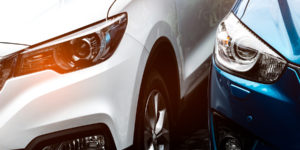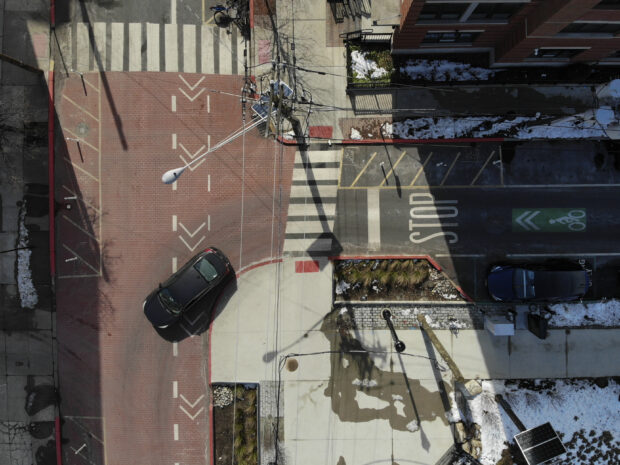Street parking was already scarce in Hoboken, N.J., when the death of an elderly pedestrian spurred city leaders to remove even more spaces in a bid to end traffic fatalities.
For seven years now, the city of nearly 60,000 people has reported resounding success: Not a single automobile occupant, bicyclist or pedestrian has died in a traffic crash since January 2017, elevating Hoboken as a national model for roadway safety.
Mayor Ravi Bhalla was a City Council member in 2015 when a van struck 89-year-old Agnes Accera as she crossed Washington Street in the bustling downtown business district. Bhalla didn’t know Accera but attended her wake and said her death inspired him to push for better safety.
“I felt it wasn’t acceptable,” Bhalla said. “Our seniors, who we owe the greatest duty of safety to, should be able to pass that street as safely as possible. For her to actually be killed was a trigger that we needed to take action.”
Bhalla became mayor in 2018 and the city fully committed to Vision Zero: a set of guidelines adopted by numerous cities, states and nations seeking to eliminate traffic deaths. Proponents believe no accident is truly unavoidable and even want to do away with the word “accident” altogether when describing roadway fatalities.
Sweden originated the concept more than a quarter-century ago, and U.S. Transportation Secretary Pete Buttigieg touted Hoboken in 2022 when announcing his department would follow Vision Zero guidelines. Major U.S. cities including New York, Minneapolis, San Francisco, Baltimore and Portland, Ore., have integrated aspects of the program into their safety plans, including at least some form of daylighting, the term for the removal of parking spaces near intersections to improve visibility.
Hoboken’s success has chipped away at the notion that reaching zero traffic deaths is more aspirational than achievable.
“That goal is obviously bold,” said Leah Shahum, founder and director of the Vision Zero Network, a nonprofit advocating for street safety. “It’s also meant to help us kind of shake off the complacency that we’ve had for too long that traffic deaths are inevitable, that what we’re experiencing today is just an unfortunate and unavailable byproduct of modern society. That’s not the case.”
While Hoboken’s plan has numerous components, including lower speed limits and staggered traffic lights, daylighting is often credited as one of the biggest reasons its fatalities have dropped to zero.
Ryan Sharp, the city’s transportation director, said when roads need to be repaved, Hoboken takes the additional step of cordoning off the street corners to widen curbs and shorten crosswalks. It’s already illegal to park at an intersection in Hoboken, but drivers often do anyway if there aren’t physical barriers.
Some of the new concrete structures are equipped with bike racks, benches and even rain garden planters that help absorb stormwater runoff. If there isn’t enough money for an infrastructure solution right away, the city puts up temporary bollards.
“There really isn’t a silver bullet or any magic, innovative thing where we’ve cracked a code,” Sharp said. “Our approach has been more about focusing on the fundamentals. We’ve created a program where we’re layering these things in year after year.”
But removing parking from a place where it’s in short supply has critics.
Joe Picolli, who opened Hoboken Barber Shop on Washington Street in 2018, said the curb extensions — or bumpouts — have made it difficult for downtown merchants to win back business lost during the pandemic.
“Before the bumpouts, there were a lot more buses, a lot more cars, a lot more parking,” said Picolli, who lives in Point Pleasant, New Jersey, and sometimes has to trail street sweepers to find parking. “It’s good as far as people walking on the street, but it’s bad because you’re not getting the flow from other towns.”
Although a bit larger than its Mile Square City nickname would imply, Hoboken ranks fourth nationwide in population density, trailing three other New Jersey cities and two spots ahead of New York, according to 2022 census data.
While the compact footprint means everyone is within range of public transit, cars still crowd the major streets and curbsides.
“We’re not New York City, but we’re not a suburb, either,” said Tammy Peng, who has lived in Hoboken for more than 15 years. “We’re kind of a weird in between. A lot of families keep a car because they want to run errands on the weekend, but Monday to Friday they’re commuting into the city.”
While daylighting slightly lengthens her trips to soccer practice or the grocery store, Peng said it’s much easier to spot pedestrians crossing the street.
Overall fatality numbers have remained largely unchanged since New York joined the Vision Zero movement in 2014 with a plan that included widening some curbs. Mayor Eric Adams boosted the city’s commitment in November by promising to daylight 1,000 intersections each year.
Some cities have even used the practice to beautify their downtowns. Baltimore hired artists to liven up curb extensions with geometric shapes and vibrant colors.
States are embracing daylighting as well. More than 40 had enacted some sort of daylighting law when California’s Legislature approved a new statewide rule in 2023 that prohibits parking within 20 feet (6 meters) of an intersection. Cities can set shorter distances with proof their plans are safe. Violators started receiving warnings in January and face fines beginning early next year.
Assemblymember Alex Lee, who authored California’s legislation, said he was troubled by the fact that his state’s traffic fatalities were even higher than the national average, with around 1,100 pedestrians killed in both 2021 and 2022. Deaths were recorded at a similar pace through the first six months of 2023.
Although cities in the nation’s most populous state range from behemoth metropolises to sparsely populated rural communities, Lee figured a statewide standard would eliminate any confusion. The only thing better, he contends, would be a national standard.
“Just as I assume in every state you can’t park in front of a fire hydrant or can’t park close to the train track, it should be the same whether you’re in California or Nebraska,” Lee said.
Stefanie Seskin, director of policy and practice at the National Association of City Transportation Officials, said signs are fine, but not nearly as effective as infrastructure changes.
“It certainly takes a next level of chutzpah for a driver to park on a curb extension than it does to park where a sign says ‘please don’t,'” Seskin said.
Jeff Speck, author of the book “Walkable City,” which makes the case for pedestrian-friendly downtowns, commends cities like Hoboken for improving visibility at intersections. However, he said some communities go too far by taking away too many parking spaces without adding physical barriers, creating broad “sight triangles” leading to increased speeding.
“What a number of cities have done is overreacted to the laudable goal of daylighting and placed oversized no-parking zones around every driveway and curb cut,” Speck said. “That’s counterproductive.”
In 2012, Seattle was one of the first major U.S. cities to pursue zero traffic deaths. Mike McGinn, the mayor at the time, said he wanted to recalibrate the public’s expectation of road safety to make it more akin to their thoughts on airplane safety, where no fatality is considered acceptable.
Why, he asks, should downtown areas where people work, shop, or attend entertainment events have to settle for a lower standard?
“This is literally the easiest real estate that should be given over to safety,” said McGinn, now executive director of the pedestrian advocacy group America Walks. “It’s low-hanging fruit.”





















 Allstate’s Safe Driving App Helps Reduce Chance of Collision by 25%
Allstate’s Safe Driving App Helps Reduce Chance of Collision by 25%  Chubb Gets Its Paws on Pet Insurance MGA
Chubb Gets Its Paws on Pet Insurance MGA  USAA to Lay Off 220 Employees
USAA to Lay Off 220 Employees  New Atlantic Hurricane Forecast Calls for 33 Named Storms
New Atlantic Hurricane Forecast Calls for 33 Named Storms 